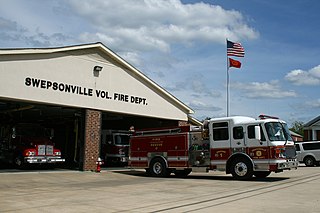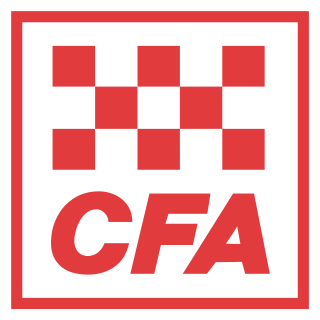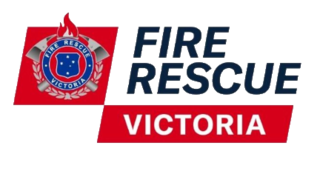
A volunteer fire department (VFD) is a fire department of volunteers who perform fire suppression and other related emergency services for a local jurisdiction. Volunteer and retained (on-call) firefighters are expected to be on call to respond to emergency calls for long periods of time, and are summoned to the fire station when their services are needed. They are also expected to attend other non-emergency duties as well.

Tathra is a seaside town on the Sapphire Coast found on the South Coast, New South Wales, Australia. As at the 2016 census, Tathra had a population of 1,675.

The Country Fire Authority (CFA) is a volunteer fire service responsible for fire suppression, rescues, and response to other accidents and hazards across most of the state Victoria, Australia. CFA comprises over 1,200 brigades organised in 21 districts, and shares responsibility for fire services with Fire Rescue Victoria (FRV), which employs full-time paid firefighters in major urban areas; and Forest Fire Management Victoria (FFMV), which manages fire prevention and suppression on Victoria's public lands. CFA operations and equipment are partly funded by the Victorian Government through its Fire Services Levy, and supplemented by individual brigades' fundraising for vehicles and equipment.

The New South Wales Rural Fire Service is a volunteer-based firefighting agency and statutory body of the Government of New South Wales.

Mount Riverview is a town off the Great Western Highway about 2 km NE of Blaxland in the Lower Blue Mountains, New South Wales, 70 kilometres west of the Sydney CBD, Australia. At the 2006 census, Mount Riverview had a population of 2,993 people.
Philip Christian Koperberg, is the Chairman of the New South Wales Emergency Management Committee, responsible for advising the New South Wales government on emergency response strategies, since 2011.
In Australia, during winter and spring 2001, low rainfall across combined with a hot, dry December created ideal conditions for bushfires. On the day of Christmas Eve, firefighters from the Grose Vale Rural Fire Service (RFS) brigade attended a blaze in rugged terrain at the end of Cabbage Tree Rd, Grose Vale, believed to have been caused by power lines in the Grose Valley.

The 1994 eastern seaboard fires were significant Australian bushfires that occurred in New South Wales, Australia during the bushfire season of 1993–1994. Some 20,000 firefighters were deployed against some 800 fires throughout the state, and along the coast and ranges from Batemans Bay in the south to the Queensland border in the north, including populated areas of the city of Sydney, the Blue Mountains and the Central Coast. The fires caused mass evacuations of many thousands of people, claimed four lives, destroyed some 225 homes and burned out 800,000 hectares of bushland. The firefighting effort raised in response was one of the largest seen in Australian history.

Firefighting has historically been a predominantly male profession throughout the world. However, since the 1970s, women have made inroads in both professional and volunteer fire departments in multiple countries. In modern times, women have served in a variety of fire service roles including as fire chiefs. Nonetheless, they comprise less than 20% of firefighters even in the countries where they are best represented.
Shane Alan Fitzsimmons was the Head of Resilience NSW and was previously the Commissioner of the New South Wales Rural Fire Service between September 2007 and April 2020.
Firefighting is the act of extinguishing destructive fires. A firefighter fights these fires with the intent to prevent destruction of life, property and the environment. Firefighting is a highly technical profession, which requires years of training and education in order to become proficient. A fire can rapidly spread and endanger many lives; however, with modern firefighting techniques, catastrophe can usually be avoided. To help prevent fires from starting, a firefighter's duties include public education and conducting fire inspections. Because firefighters are often the first responders to victims in critical conditions, firefighters often also provide basic life support as emergency medical technicians or advanced life support as licensed paramedics. Firefighters make up one of the major emergency services, along with the emergency medical service, the police, and many others.

The Queensland Fire and Emergency Services (QFES) is the primary provider of fire and emergency services in Queensland, Australia. The QFES was established in 2013. The QFES has committed to adopting an "all hazards" approach to emergency management.

Bushfires in Australia are a widespread and regular occurrence that have contributed significantly to shaping the nature of the continent over millions of years. Eastern Australia is one of the most fire-prone regions of the world, and its predominant eucalyptus forests have evolved to thrive on the phenomenon of bushfire. However, the fires can cause significant property damage and loss of both human and animal life. Bushfires have killed approximately 800 people in Australia since 1851, and billions of animals.

Fire Rescue Victoria (FRV) is a fire and rescue service in the state of Victoria, Australia, that provides firefighting, rescue, HAZMAT and Emergency Medical Response services in areas of metropolitan Melbourne and major regional centres throughout Victoria.

Windellama is a rural locality in the Southern Tablelands of New South Wales, Australia in the Goulburn Mulwaree Council. It is northeast of Canberra and southeast of Goulburn. At the 2021 census, it had a population of 417. Windellama is a popular location for people from Sydney to make a "tree change". This has created a change in property sizes in the area, previously mostly large agricultural enterprises, now on a multitude of 50-100 acre hobby farms.

The bushfire season of the summer of 2017–18, was expected to have above normal bushfire risks with an elevated fire risk for the most of eastern and south Australian coastal areas. Australia had experienced its warmest winter on record and the ninth driest winter on record leaving dry fuel loads across much of southern Australia. Expected warmer weather over the summer period would also increase the risk. Bushfires were also expected to occur earlier, before the end of winter, as a result of the warm and dry winter. Both Queensland and north-eastern New South Wales experienced the wettest October since 1975 leading to a downgrade in bushfire risk.
The 2018 Tathra bushfire was a bushfire that burned between 18 and 19 March 2018 and primarily affected parts of the South Coast region in the Australian state of New South Wales. The fire, understood to have been caused by a failure in electrical infrastructure, began in the locality of Reedy Swamp, near Tarraganda, which spread east towards Tathra in the municipality of the Bega Valley Shire.

The 2019–20 Australian bushfire season, or Black Summer, was one of the most intense and catastrophic fire seasons on record in Australia. It included a period of bushfires in many parts of Australia, which, due to its unusual intensity, size, duration, and uncontrollable dimension, was considered a megafire by media at the time. Exceptionally dry conditions, a lack of soil moisture, and early fires in Central Queensland led to an early start to the bushfire season, beginning in June 2019. Hundreds of fires burnt, mainly in the southeast of the country, until May 2020. The most severe fires peaked from December 2019 to January 2020.
The NSW Premier's Bushfire Emergency Citation is an award issued by the Premier of New South Wales for emergency service in the 2019–20 Australian bushfire season in New South Wales.
Greg Mullins is an Australian firefighter. He is a former Commissioner of Fire and Rescue New South Wales, a Climate Councillor with the Climate Council and a founding member of Emergency Leaders for Climate Action.






























